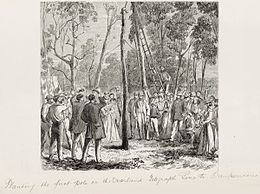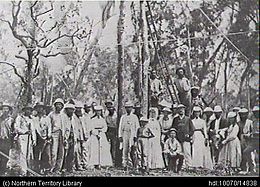- Australian Overland Telegraph Line
-
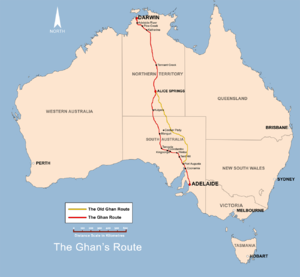 The (subsequent) Adelaide-Darwin railway follows the route of the Telegraph Line, using the easternmost (yellow) path. The railway was finished as far as Alice Springs on 6 August 1929, and as far as Darwin in 2003.
The (subsequent) Adelaide-Darwin railway follows the route of the Telegraph Line, using the easternmost (yellow) path. The railway was finished as far as Alice Springs on 6 August 1929, and as far as Darwin in 2003.
The Australian Overland Telegraph Line was a 3200 km telegraph line that connected Darwin with Port Augusta in South Australia. Completed in 1872 the Overland Telegraph Line allowed fast communication between Australia and the rest of the world. An additional section was added in 1877 with the completion of the Western Australian section of the line. It was one of the great engineering feats of 19th century Australia[1] and probably the most significant milestone in Australia's telegraphic history.[2]
Contents
Conception and Competition
By 1855 speculation had intensified about possible routes for the connection of Australia to the new telegraph cable in Java and thus Europe. Among the routes under consideration were either Ceylon to Albany in Western Australia, or Java to the north coast of Australia and then either onto east coast, or south through the centre of the continent to Adelaide.[3]
Competition between the colonies over the route was fierce. The Victorian government organised an expedition led by Burke and Wills to cross the continent from Menindee to the Gulf of Carpentaria in 1860. Although the route was traversed, the expedition ended in disaster. The South Australian government recognised the economic benefits that would result from becoming the centre of the telegraph network. It offered a reward of £2000 to encourage an expedition to find a route between South Australia and the north coast.[3]
John McDouall Stuart had meanwhile also been endeavouring to cross the continent starting from the northern Flinders Ranges, and was successful on his sixth attempt in 1862. James Chambers had gained an interest in the concept of a telegraph line across the outback. He paid the costs for Stuart's expeditions into northern Australia.[4]
Stuart had the proposed telegraph line in mind as he travelled across the desert, noting the best places for river crossings, sources of timber for telegraph poles, and water supplies. On 24 July his expedition finally reached the north coast at a place Stuart named Chambers Bay, after his employer and sponsor. South Australian Governor Richard MacDonnell gave his strong support to the project.
In 1863 an Order in Council transferred Northern Territory to South Australia, aiming to secure land for an international telegraph connection.[5] Now with a potential route, South Australia strengthened her position for the telegraph line in 1865 when Parliament authorised the construction of a telegraph line between Adelaide and Port Augusta, 300 km to the north. This move provoked outrage in Queensland amongst advocates of the Darwin - Burketown route.
The final contract was secured in 1870 when the South Australian government agreed to construct 3200 km of line to Darwin, while the British-Australian Telegraph Company promised to lay the undersea cable from Java to Darwin. The latter was to be finished on 31 December 1871, and severe penalties were to apply if the connecting link was not ready.[3]
Construction
The South Australian Superintendent of Telegraphs, Charles Todd, was appointed head of the project,[6] and devised a timetable to complete the immense project on schedule. Todd had built South Australia's first telegraph line and extended it to Melbourne.[5] The contract stipulated a total cost of no more than ₤128,000 and two years' construction time.[5] He divided the route into three regions: northern and southern sections to be handled by private contractors, and a central section which would be constructed by his own department.[3] The telegraph line would comprise more than 30,000 wrought iron poles, insulators, batteries, wire and other equipment, ordered from England.[7] The poles were placed 80 m apart and repeater stations built every 250 km.[8]
Todd assembled a team of men from all walks of life: surveyors, linesmen, carpenters, labourers and cooks. The team left Adelaide with horses, bullocks and carts loaded with provisions and equipment for many weeks. The central section would be surveyed by the explorer John Ross.[7] William Dalwood and Joseph Derwent arrived in Darwin on board the SS Omeo with eighty men and the equipment required to construct the Northern section of the line from Darwin to Tennant Creek.[7] The southern section from Port Augusta to Alberga Creek was contracted to Edward Meade Bagot.
The northern line was progressing well until the onset of the wet season in November 1870.[7] Heavy rain of up to 10 inches (250 mm) a day waterlogged the ground and made it impossible for work to progress. With conditions worsening, the men went on strike on 7 March 1871, rancid food and disease-spreading mosquitoes amongst their complaints.[7] Weeks later the overseer, McMinn decided to rescind the contract for the northern section. The South Australian government was now forced to construct an extra 700 km of line, placing considerable stress on its teams. It was another six months before reinforcements led by engineer Robert Patterson arrived in Darwin.
As the central and southern sections neared completion, Patterson decided to take a different strategy with the construction of the northern section. It was divided into four sub-sections with the majority of the men on the most northerly section.[9] If the construction deadline of 31 December was missed, then the gap could be filled by using a pony express.[9] The undersea cable was finished earlier than expected,[5] with the line from Java reaching Darwin on 18 November 1871 and being connected the following day.[9]
Because of the problems still facing the northern section, the Queensland Superintendent of Telegraphs called for the abandonment of the project, but work went on nevertheless.[9] By the end of the year there was still over 300 km of line to erect.[9] During this time Todd began visiting workers along the line to lift their spirits.[5] The message he sent along the incomplete line on 22 May 1872, took 9 days to reach Adelaide.[9]
Completion
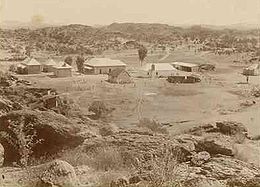 Repeater station at Alice Springs, c. 1880
Repeater station at Alice Springs, c. 1880
Running more than seven months late, the two lines were finally joined at Frew's Ponds on Thursday, 22 August 1872.[10] Todd was given the honour of sending the first message along the completed line:
- WE HAVE THIS DAY, WITHIN TWO YEARS, COMPLETED A LINE OF COMMUNICATIONS TWO THOUSAND MILES LONG THROUGH THE VERY CENTRE OF AUSTRALIA, UNTIL A FEW YEARS AGO A TERRA INCOGNITA BELIEVED TO BE A DESERT +++
The line proved an immediate success in opening the Northern Territory; gold discoveries were made in several places along the northern section (in particular Pine Creek), and the repeater stations in the MacDonnell Ranges proved invaluable starting points for explorers like Ernest Giles, W. C. Gosse, and Peter Egerton-Warburton who were heading west. Within the first year of operations 4000 telegrams were transmitted.[8] Maintenance was an ongoing and mammoth task, with floods often destroying poles. The extreme remoteness of many of the repeater stations also proved a hazard: on 22 September 1874 Aborigines attacked the station at Barrow Creek, and killed two operators. A policeman stationed there, Samuel Gason, later led a reprisal attack.
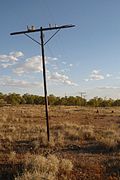 Remains of the Overland Telegraph line at Tennant Creek converted into telephone circuits.
Remains of the Overland Telegraph line at Tennant Creek converted into telephone circuits.
In February 1875, several Overland Telegraph employees departed Port Darwin and were returning to Adelaide on the ill-fated SS Gothenburg. A few days later, they lost their lives in the shipwreck after the Gothenburg hit a section of the Great Barrier Reef and sank.[11]
The final stage of connecting Australia to the world was begun in 1875 when the Western Australian and South Australian governments agreed to build a line across the Nullarbor plain. This equally challenging project was completed in 1877.
Around 1871, a second cable connected Java with an overland line from Perth to Roebuck Bay.
When Darwin was bombed in World War II the line was deliberately cut just before the attack.[5][6]
Competition
Before long, competing telegraph line from Java to Roebuck Bay in Western Australia opened for business.
References
- Citations
- ^ W.A. Crowder’s diary: the Overland Telegraph Line National Library of Australia.
- ^ Wendy Lewis, Simon Balderstone and John Bowan (2006). Events That Shaped Australia. New Holland. p. 66. ISBN 9781741104929.
- ^ a b c d Exploring the Stuart Highway : further than the eye can see, 1997, p. 24
- ^ Phillips, Valmai (1984). Enterprising Australians. Kensington, New South Wales: Bay Books. p. 17. ISBN 0858356473.
- ^ a b c d e f Darcy Yuille (director), Wendy Hughes (narrator) (18 March 2007). Constructing Australia:A Wire Through the Heart (DVD). Film Australia. http://www.imdb.com/title/tt0997999/. Retrieved 17 December 2009.
- ^ a b "Plan of Overland Telegraph Line". SA Memory. Government of South Australia. http://samemory.sa.gov.au/site/page.cfm?c=1551. Retrieved 17 December 2009.
- ^ a b c d e Exploring the Stuart Highway : further than the eye can see, 1997, p. 25
- ^ a b Stanton, Jenny (2000). The Australian Geographic Book of the Red Centre. Terrey Hills, New South Wales: Australian Geographic. p. 42. ISBN 1862760136.
- ^ a b c d e f Exploring the Stuart Highway : further than the eye can see, 1997, p. 26
- ^ Exploring the Stuart Highway : further than the eye can see, 1997, p. 27
- ^ The Wreck of the Gothenburg (1875). On her voyage from Port Darwin to Adelaide. Printed by J.H. Lewis, Printer & Publisher, Adelaide.
- Bibliography
- Exploring the Stuart Highway : further than the eye can see. West Beach, South Australia: Tourist Information Distributors Australia, 1997. ISSN 1326-6039
External links
- Communication by Post, Telephones and Telegraph, 1800-1970
- Connecting a Continent : Early Telecommunications in Australia
- Overland Telegraph Line at Flinders Ranges Research
Coordinates: 25°55′37.77″S 134°58′25.58″E / 25.9271583°S 134.9737722°E
Categories:- History of Australia (1851–1900)
- History of South Australia
- Buildings and structures in Alice Springs
- History of the Northern Territory
- Telegraphy
Wikimedia Foundation. 2010.

